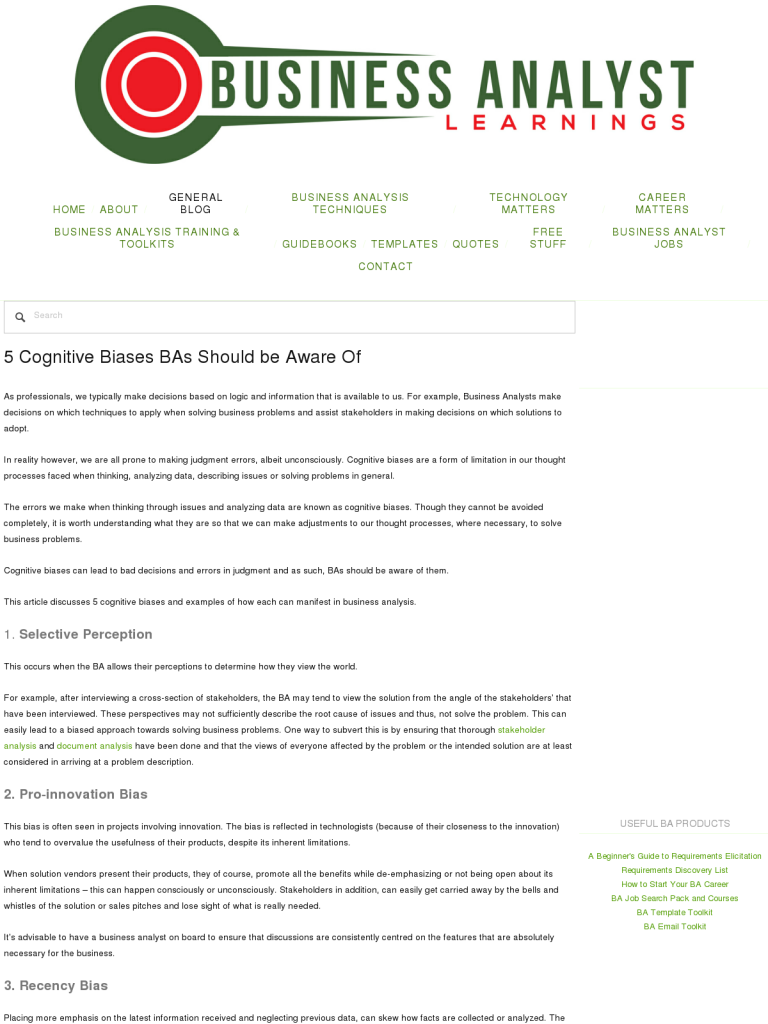5 Cognitive Biases BAs Should be Aware Of
Blog: Business Analyst Learnings Blog
As professionals, we typically make decisions based on logic and information that is available to us. For example, Business Analysts make decisions on which techniques to apply when solving business problems and assist stakeholders in making decisions on which solutions to adopt.
In reality however, we are all prone to making judgment errors, albeit unconsciously. Cognitive biases are a form of limitation in our thought processes faced when thinking, analyzing data, describing issues or solving problems in general.
The errors we make when thinking through issues and analyzing data are known as cognitive biases. Though they cannot be avoided completely, it is worth understanding what they are so that we can make adjustments to our thought processes, where necessary, to solve business problems.
Cognitive biases can lead to bad decisions and errors in judgment and as such, BAs should be aware of them.
This article discusses 5 cognitive biases and examples of how each can manifest in business analysis.
1. Selective Perception
This occurs when the BA allows their perceptions to determine how they view the world.
For example, after interviewing a cross-section of stakeholders, the BA may tend to view the solution from the angle of the stakeholders’ that have been interviewed. These perspectives may not sufficiently describe the root cause of issues and thus, not solve the problem. This can easily lead to a biased approach towards solving business problems. One way to subvert this is by ensuring that thorough stakeholder analysis and document analysis have been done and that the views of everyone affected by the problem or the intended solution are at least considered in arriving at a problem description.
2. Pro-innovation Bias
This bias is often seen in projects involving innovation. The bias is reflected in technologists (because of their closeness to the innovation) who tend to overvalue the usefulness of their products, despite its inherent limitations.
When solution vendors present their products, they of course, promote all the benefits while de-emphasizing or not being open about its inherent limitations – this can happen consciously or unconsciously. Stakeholders in addition, can easily get carried away by the bells and whistles of the solution or sales pitches and lose sight of what is really needed.
It’s advisable to have a business analyst on board to ensure that discussions are consistently centred on the features that are absolutely necessary for the business.
3. Recency Bias
Placing more emphasis on the latest information received and neglecting previous data, can skew how facts are collected or analyzed. The fact that recent information shows a certain trend should not be misinterpreted as the norm.
For example, when trying to understand the root cause of a business problem, the BA should examine both current and historical information in order to get a full picture. Past occurrences are a valuable source of information to explore.
4. Ostrich Effect
This bias is very common, and is reflected when the BA ignores negative information during the course of the project. It is often termed, “burying one’s head in the sand.“
The Ostrich effect is manifested when BAs avoid unpleasant information. This is counterproductive because ignoring issues won’t make then go away. Cultivate the habit of confronting issues and improving the situation as soon as you identify gaps.
The fact that you’re consciously avoiding negative information certainly implies that there’s more to the situation than meets the eye. BAs should always work with an “inquisitive mind” to ensure that they have sufficient information (whether negative or positive) to advise the business.
5. Choice-supportive Bias
This sort of bias reflects the tendency to feel positive about a decision that one recommended, even where there are flaws in it. BAs should look beyond their roles in the situation and focus more on the outcome of the decision that has been made and how it will affect the business on the long run. Corrective steps should always be taken regardless of sunk costs or our roles in the decision-making process, no matter how late in the game, to prevent further losses.
A cognitive bias can be defined as a mistake in reasoning or evaluation that is caused by placing emphasis on one’s beliefs or opinions, regardless of contrary information. When you catch yourself thinking with bias, adjust your approach and think differently so that the desired solutions to business problems can be identified.
Image courtesy of Goldy at FreeDigitalPhotos.net
Leave a Comment
You must be logged in to post a comment.








